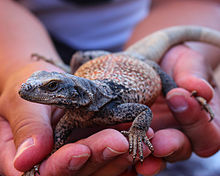List of the Cenozoic life of Nevada
This list of the Cenozoic life of Nevada contains the various prehistoric life-forms whose fossilized remains have been reported from within the US state of Nevada and are between 66 million and 10,000 years of age.
A[]
- Abies
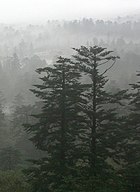 Living Abies, or fir trees
Living Abies, or fir trees- †
- †
- †
- †
- †
- †
- Acer
- †
- †
- †
- †
- †
- †
- †
- †
- †
- †
- †
- †
- †
- †
- † – type locality for species
- †Aelurodon
- †
- †Aelurodon taxoides
- †Aepycamelus
 Life restoration of the Miocene camel Aepycamelus, or the long-necked camel. Heinrich Harder (1920).
Life restoration of the Miocene camel Aepycamelus, or the long-necked camel. Heinrich Harder (1920).- †Aepycamelus bradyi – type locality for species
- †Aepycamelus robustus – or unidentified comparable form
- †Aepycamelus stocki
- †Aesculus
- † – type locality for species
- †
- †Agriotherium
- †Agulla
- †Agulla mineralensis – type locality for species
- †Aletomeryx
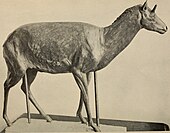 Restorative model of the Miocene deer relative Aletomeryx
Restorative model of the Miocene deer relative Aletomeryx - †Alforjas
- †
- †
- †
- †
- †
- †
- †
- Alnus
- †
- †
- †
- †
- † – type locality for species
- †
- †
- † – or unidentified comparable form
- †
- Amelanchier
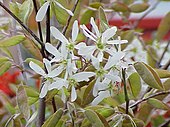 Flowers and foliage of Amelanchier, or shadbush
Flowers and foliage of Amelanchier, or shadbush- †
- †
- †
- †
- † – type locality for species
- † – type locality for genus
- † – type locality for species
- †Amorpha
- †
- †
- †Anchitheriomys
- †
- † – type locality for species
- †
- †
- † – or unidentified comparable form
- †
- †
- Antrozous
- †Antrozous pallidus
- †Apatemys
- †
- †Aphelops
- †
- †
- †Apis
- †Apis nearctica – type locality for species
- Arbutus
- †
- †
- †Arbutus menziesii
- †
- †Arctodus
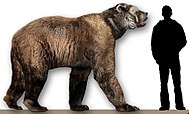 Restoration of an Arctodus, or short-faced bear, with a human to scale
Restoration of an Arctodus, or short-faced bear, with a human to scale- †Arctodus simus
- †Arctostaphylos
- †
- †Astrohippus
B[]
- †BarbourofelisFossilized skull of the Miocene-Pliocene false saber-toothed cat Barbourofelis
- †Barbourofelis fricki
- † – type locality for genus
- † – type locality for species
- Bassariscus
- †
- †
- † – or unidentified comparable form
- † – or unidentified comparable form
- † – type locality for species
- Betula
- †
- †
- †
- †
- †
- †
- †
- †Borophagus
- †Borophagus diversidens – or unidentified comparable form
- †
- †
- †
- †Brachycrus
 Restorative portrait of the Miocene oreodont mammal Brachycrus
Restorative portrait of the Miocene oreodont mammal Brachycrus - †
- †
- Brachylagus
- †Brachylagus idahoensis
- †Brachypsalis
- †
- † – type locality for genus
- † – type locality for species
- †Bumelia
- †
C[]
- †Calocedrus
- †
- †Camelops – tentative report
 Life restoration of the Pliocene-Holocene camel Camelops
Life restoration of the Pliocene-Holocene camel Camelops - Candona
- Canis
- †Canis latrans
- †Canis lepophagus
- †
- †Carpocyon
- †
- Carya
- †
- †Carya ovata
- Castanopsis
- †
- Ceanothus
- †
- †
- †
- Cedrela
- †
- †Ceratophyllum
- †
- Cercis
- † – type locality for species
- †Cercocarpus
- †
- †
- †
- † – type locality for species
- †
- †Chamaebatia
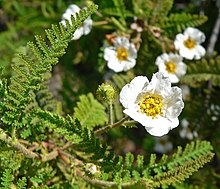 Chamaebatia
Chamaebatia- †
- †Chamaecyparis
- †
- †
- Chara
- †
- †Chrysolepis
- †
- †
- Cnemidophorus
- †Cnemidophorus tigris
- Comptonia
- † – type locality for species
- †
- † – type locality for species
- †
- Cornus
- †
- †Cosoryx
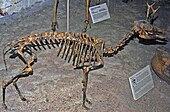 Fossilized skeleton of the Miocene pronghorn-relative Cosoryx
Fossilized skeleton of the Miocene pronghorn-relative Cosoryx- †Cosoryx furcatus
- Crataegus
- †
- †
- †
- †
- Crotalus
- †Crotalus atrox
- †
- †Crotalus viridis
- Crotaphytus
- †Crotaphytus collaris
- †
- †
- †
- †
- †Cuvieronius – tentative report
 Life restoration of the Pliocene-Holocene elephant relative Cuvieronius
Life restoration of the Pliocene-Holocene elephant relative Cuvieronius
D[]
- †
- †
- †Desmatippus
- † – or unidentified comparable form
- †Diceratherium – or unidentified comparable form
- †DinohippusMounted fossilized skeleton of the Miocene-Pliocene horse Dinohippus
- †Diospyros
- †
- Dipodomys
- †
- †Dipoides
- † – or unidentified comparable form
- † – or unidentified comparable form
- †Diprionomys
- † – type locality for species
- † – type locality for species
- †
- † – or unidentified comparable form
- †Dromomeryx
- †Dromomeryx borealis
E[]
- † – type locality for genus
- † – type locality for species
- †
- †
- † – type locality for genus
- † – type locality for species
- †Epicyon
 Mounted fossilized skeleton of the Miocene bone-crushing dog Epicyon
Mounted fossilized skeleton of the Miocene bone-crushing dog Epicyon- †
- †Equisetum
- †
- Equus
- †Equus giganteus
- †Equus idahoensis
- †Equus simplicidens
- † – type locality for genus
- † – type locality for species
- † – type locality for genus
- † – type locality for species
- † – type locality for species
- †Eucastor
- †Euceratherium
 Life restoration of the Pleistocene bovid Euceratherium, or the shrub ox. Robert Bruce Horsfall (1913).
Life restoration of the Pleistocene bovid Euceratherium, or the shrub ox. Robert Bruce Horsfall (1913).- †Euceratherium collinum
- †Eucyon
- †Eucyon davisi
- Eugenia
- †
F[]
- †
- †
- †Fraxinus
 Illustrations of the flowers and foliage of a living Fraxinus, or ash tree, with insets further detailing its anatomy
Illustrations of the flowers and foliage of a living Fraxinus, or ash tree, with insets further detailing its anatomy- † – type locality for species
- †
- †
- †
- †
- †
G[]
- Gambelia
- †Garrya
- †
- †Gigantocamelus
- †
- Glyptostrobus
- †
- †Gomphotherium
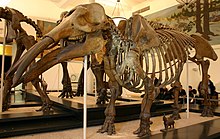 Mounted fossilized skeleton of the Miocene-Pleistocene elephant relative Gomphotherium
Mounted fossilized skeleton of the Miocene-Pleistocene elephant relative Gomphotherium- †
- Gopherus
- †Gopherus agassizii
- †Gymnocladus
- †
H[]
- †Helaletes
- †
- Heloderma
- †Heloderma suspectumGila monster
- †Hemiauchenia
- †Hemiauchenia macrocephala – or unidentified comparable form
- †
- † – or unidentified related form
- †Hesperocamelus
- † – type locality for species
- †
- †
- † – type locality for species
- †Heteromeles
- †
- †
- † – type locality for species
- †
- †Hipparion
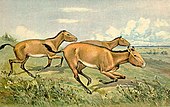
- †Hipparion tehonense
- †Hippotherium
- †Holodiscus
- †
- Hydrangea
- †
- †
- †Hyopsodus
- †
- †Hypohippus
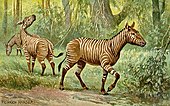
- †Hypohippus affinis
- † – type locality for species
- † – or unidentified comparable form
- †Hypolagus
- †
- †
- †
- †
- † – type locality for species
- †
- †
- † – type locality for species
- †Hyrachyus
 Life restoration of the Eocene odd-toed ungulate Hyrachyus
Life restoration of the Eocene odd-toed ungulate Hyrachyus- †
- † – tentative report
I[]
- †Ilingoceros
- †Ilingoceros alexandrae – type locality for species
- † – type locality for species
- †Indarctos
 Fossilized skull of the Miocene bear Indarctos
Fossilized skull of the Miocene bear Indarctos- †
- †Ischyrocyon
- †
- †
J[]
- Juglans
- †
- †
- JuniperusA living Juniperus, or juniper tree
- †
- †
K[]
- †
L[]
- † – type locality for genus
- † – type locality for species
- Lampropeltis
 A living Lampropeltis getula, or eastern kingsnake
A living Lampropeltis getula, or eastern kingsnake- †Lampropeltis getulus
- Larix
- †
- †
- † – type locality for species
- †
- Lemmiscus
- †Lemmiscus curtatus
- †
- †
- †Leptocyon
 Illustration of a fossilized skull of the Oligocene-Miocene dog Leptocyon
Illustration of a fossilized skull of the Oligocene-Miocene dog Leptocyon- †
- †
- †Leptocyon vafer
- †Leucothoe
- †
- †
- †
- †
- †
- † – type locality for species
- †
- †Lithocarpus
- †
- †
- † – type locality for species
- Lymnaea
 A living Lymnaea (larger) freshwater snail, or Melantho snail
A living Lymnaea (larger) freshwater snail, or Melantho snail - †Lyonothamnus
- †
- †
M[]
- †MachairodusFossilized cranium of the Miocene-Pleistocene saber-toothed cat Machairodus
- †
- † – type locality for species
- Mahonia
- †
- †
- †
- †
- †
- †
- †Mammut
- †Mammut americanum
- †Mammut matthewi
- Marmota
- † – type locality for species
- †
- †
- †
- † – tentative report
- Masticophis
- †Mastodon
 Restoration of a Mammut americanum, or American mastodon
Restoration of a Mammut americanum, or American mastodon- †
- †
- †Megahippus
- † – or unidentified comparable form
- †
- †Megalonyx
- †Megalonyx leptostomus
- †
- † – type locality for species
- †Megatylopus
- †
- †
- †Merychippus
- †
- †
- †
- †
- †Merychyus
- †
- †
- †MerycodusMounted fossilized skeleton of the Miocene pronghorn Merycodus
- † – type locality for species
- †Metalopex
- †
- †Metatomarctus
- †
- † – type locality for species
- †
- †
- †Microtomarctus
- †
- Microtus
- †
- †
- †Microtus pennsylvanicus
-
- †
- †Mimomys
- † – type locality for species
- †
- † – type locality for genus
- † – type locality for species
- †Miopelodytes – type locality for genus
- † – type locality for species
- †
- †
- †Monosaulax
- †
- †
- †Moropus
 Life restoration of the Miocene chalicothere mammal Moropus threatening a pair of the bear-dog Daphoenodon. Jay Matternes (1964).
Life restoration of the Miocene chalicothere mammal Moropus threatening a pair of the bear-dog Daphoenodon. Jay Matternes (1964).- †
- Mustela
- †
- †Mustela nigripes
- †Mustela nivalis
- Myotis
- †
- † – type locality for species
N[]
- † – type locality for genus
- † – type locality for species
- †
- †
- †Neohipparion

- † – type locality for species
- Neotoma
- † – or unidentified comparable form
- † – tentative report
- † – tentative report
- † – type locality for genus
- † – type locality for species
- †Notharctus
- Notiosorex
- †
- †
O[]
- Odocoileus
- Ondatra
- † – tentative report
- †
- †
- Oreamnos
- †Oreamnos americanus
 A living Oreamnos americanus, or mountain goat
A living Oreamnos americanus, or mountain goat
- †
- † – or unidentified comparable form
- †
- † – type locality for species
- Ostrya
- †
- Ovis
- †Ovis canadensis
P[]
- †Pachystima
- †
- † – or unidentified comparable form
- †Paenemarmota
- †
- † – type locality for genus
- † – type locality for species
- †
- †
- †Paracamelus
- †Paracosoryx
- † – or unidentified comparable form
- †
- †
- † – or unidentified related form
- †Paracynarctus
- †
- †Parahippus
- †
- †
- † – or unidentified comparable form
- †
- †
- †Paratomarctus
- †
- †Paronychomys
- † – or unidentified comparable form
- †
- †
- †Peraceras
- †
- †
- †
- †
- Perognathus
- † – or unidentified comparable form
- Peromyscus
 A living Peromyscus, or deer mouse
A living Peromyscus, or deer mouse- † – type locality for species
- †
- †
- †
- Phenacomys
- † – or unidentified comparable form
- Phrynosoma
- †Phrynosoma platyrhinos
- Picea
- †
- †
- †
- Pinus
 A living Pinus, or pine tree
A living Pinus, or pine tree- †
- †
- †
- †
- †
- †
- †
- †
- †
- Pituophis
- Platanus
- †
- †
- †
- †Platygonus
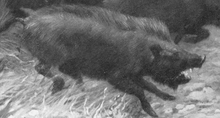 Restoration of a herd of alarmed Miocene-Pleistocene peccaries of the genus Platygonus. Charles R. Knight (1922).
Restoration of a herd of alarmed Miocene-Pleistocene peccaries of the genus Platygonus. Charles R. Knight (1922).- † – or unidentified comparable form
- †Pleiolama
- †
- †
- †
- †Pliauchenia
- †
- † – type locality for species
- †Pliohippus
- † – or unidentified comparable form
- †
- †
- † – type locality for species
- †
- †
- †
- † – type locality for species
- † – tentative report
- †
- †
- PopulusMontage of photographs in spring (top left), summer (top right), autumn (bottom left), and winter (bottom right) of Populus, or poplar tree
- †
- †
- †
- †
- †
- †
- †
- †
- † – type locality for species
- †
- †
- †
- †Procamelus
- †Procamelus grandis – or unidentified comparable form
- †
- †
- † – type locality for species
- †
- †
- † – type locality for species
- †
- † – or unidentified comparable form
- †Protolabis
- †Protolabis coartatus
- †
- †Protomarctus
- †
- †
- † – type locality for species
- †
- †
- Prunus
- †
- †
- †
- †
- †Pseudaelurus
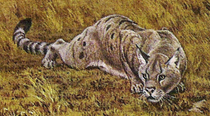 Restoration of the Miocene cat Pseudaelurus
Restoration of the Miocene cat Pseudaelurus- †
- †Pseudocamponotus – type locality for genus
- † – type locality for species
- †
- †Pseudotsuga
- †
- Pteridium
- †
- Pterocarya
- †
Q[]
- Quercus
 A living Quercus, or oak tree
A living Quercus, or oak tree- †
- †
- †
- †
- †
- †
- †
- †
R[]
- †Rana
- † – type locality for species
- †Rana pipiens
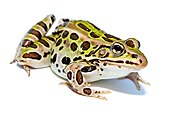 A living Lithobates pipiens (sometimes Rana pipiens), or northern leopard frog
A living Lithobates pipiens (sometimes Rana pipiens), or northern leopard frog
- †Reithroparamys
- †
- † – or unidentified comparable form
- †Repomys
- † – or unidentified comparable form
- †
- †Rhamnus
- †
- †
- Rhododendron
- †
- †Rhynchotherium
 Restoration of the Miocene-Pliocene elephant relative Rhynchotherium
Restoration of the Miocene-Pliocene elephant relative Rhynchotherium - Rhyncolus
- † – type locality for species
- †Ribes
- †
- ��
- †
- †
- †
- †Robinia
- †
- †
- Rosa
- †
- †
S[]
- Salix
 A living Salix, or willow
A living Salix, or willow- †
- †
- †
- †
- †
- †
- †
- †
- †
- †
- †
- †
- †
- †Satherium
- Sauromalus
- †Sauromalus obesus
- Scapanus
- †
- Sciurus
- † – type locality for species
- †Sequoiadendron
- †Sequoiadendron chaneyi – type locality for species
- †
- † – type locality for genus
- † – type locality for species
- †
- † – type locality for species
- †Sinopa
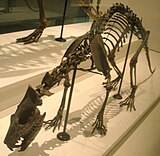 Fossilized skeleton of the Eocene-Oligocene creodont mammal Sinopa
Fossilized skeleton of the Eocene-Oligocene creodont mammal Sinopa- †
- †Sophora
- †
- †Sorbus
- †
- †
- †
- Sorex
- †Sparganium
- †
- Spea
- † – type locality for species
- Spermophilus
- †
- †
- †
- Sphaerium
- †
- † – type locality for species
- †Steneofiber
- †
- †Styrax
- †
- †Subdromomeryx

- †Subdromomeryx antilopinus – or unidentified related form
- †Symphoricarpos
- † – type locality for species
T[]
- Tamias
- †
- †
- † – type locality for species
- †
- Taxidea
- Taxodium
- †
- †Teleoceras
 Restoration of the Miocene-Pliocene rhinoceros Teleoceras
Restoration of the Miocene-Pliocene rhinoceros Teleoceras- †
- †
- †Teleoceras major
- †
- † – tentative report
- † – or unidentified comparable form
- †
- Thomomys
- † – type locality for species
- †Thuja
- †
- †Ticholeptus
 Fossilized skull of the Miocene oreodont mammal Ticholeptus
Fossilized skull of the Miocene oreodont mammal Ticholeptus- †
- Tipula
- † – type locality for species
- †Tomarctus
- †Tomarctus brevirostris
- †Torreya
- † – type locality for species
- †
- †
- †Tsuga
- †
- †
- Typha
- †
- †
U[]
- †Uintasorex
- Ulmus
- †
- †
- †Ursavus
- † – or unidentified comparable form
- †
- † – or unidentified comparable form
- Ursus
- †Ursus abstrusus
- †Ursus americanus
- †Ursus arctos – or unidentified comparable form
 A living Ursus arctos, or brown bear
A living Ursus arctos, or brown bear
V[]
- †Vaccinium
 A variety of modern Vaccinium species, clockwise from top right: cranberries, lingonberries, blueberries, and huckleberries
A variety of modern Vaccinium species, clockwise from top right: cranberries, lingonberries, blueberries, and huckleberries- †
- †Viverravus
- †
- Vulpes
- †
Z[]
- Zelkova
- †
- † – type locality for species
- †Zygolophodon
 Fossilized cranium of the Miocene-Pleistocene mastodon relative Zygolophodon
Fossilized cranium of the Miocene-Pleistocene mastodon relative Zygolophodon
References[]
- Various Contributors to the Paleobiology Database. "Fossilworks: Gateway to the Paleobiology Database". Retrieved 17 December 2021.
{{cite web}}:|author=has generic name (help)
Categories:
- Paleontology in Nevada
- Lists of the Cenozoic life of the United States by state










































